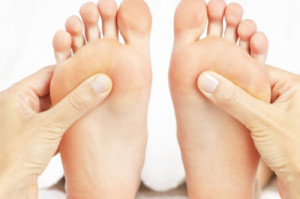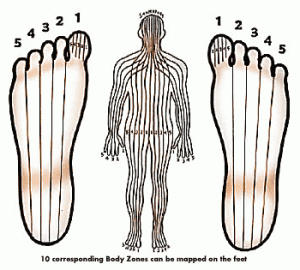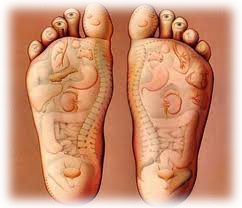Reflexology is based on the principle that reflex points on the soles, tops, and sides of the feet correspond to different areas of the body. In this way, the feet can be seen as a ‘map’ of the body. By applying specialised massage techniques to specific reflex points – using the thumbs, fingers and knuckles – the aim of a reflexology treatment is to help restore balance to the body naturally, and improve the client’s general well-being. Working on the feet there are thousand of nerve endings that are stimulated through the application of pressure on reflex points that correspond with the areas (zones) of the body helping to unblock the meridian (energy) pathways & breaking down any crystalline deposits.
Some therapists may also work reflex points on the hands, ears and face, however it is the feet that are most commonly treated in reflexology.
Benefits
- balances energy, helping the body return to a state of equilibrium on an emotional, mental
and physical level - increases circulation
- boosts the lymphatic system
- improves immune system and eliminates toxins
- deeply relaxing, relieving physical and mental fatigue
- helps the body rejuvenate itself
- releases endorphins which creates a feeling of well-being
- pain relief
- stimulates and soothes the nervous system
- balancing effect on the endocrine system
- affects blood pressure, having a normalising effect
Treatment
Removal of shoes & socks only, you will sit back & relax while the feet are cleansed. Breathing techniques are encouraged to aid relaxation at the beginning, while massage of the feet to warm up takes place. The reflexology acupressure points are applied and to finish a foot and lower leg massage.
HISTORY
There is evidence of some form of foot and hand therapy being practiced in China as long ago as 4,000 B.C. and also at the same time in Egypt, as depicted in the tomb of Ankmahor. The North American tribes of Indians are known to have practiced a form of foot therapy for hundreds of years.
The more modern form of reflexology was first pioneered by an ear, nose and throat surgeon by the name of Dr William Fitzgerald (1872-1942). Dr Fitzgerald was the founder of Zone Therapy, which was an earlier form of reflexology. He discovered that exerting pressure on the tips of the toes or fingers caused corresponding parts of the body to become anaesthetised. From this, Dr Fitzgerald divided the body into ten equal zones, which ran from the top of the head to the ends of the toes. By using tight elastic bands on the middle sections of the fingers, or using small clamps on the tips of the fingers, minor surgery could be carried out with no further anaesthetic agents required.
However, reflexology as we know it today was pioneered by a woman called Eunice Ingham (1889 – 1974), or the mother of modern reflexology. Eunice Ingham was a physiotherapist working in a doctor’s practise using the zone therapy developed by Dr Fitzgerald. Ms Ingham thought, however, that it would be more effective to be practised on the feet rather than the hands. After extensive research, she developed the map of the entire body on the feet – where one point on the foot corresponds to a certain part of the body. By using acupressure or massage techniques on these points, a positive effect is created in the corresponding body part.
Eunice Ingham spent 30 years travelling around America teaching her reflexology first to medical staff, and then to non-medical practitioners. Modern Western reflexology uses the charts and theories developed by her and now called the Ingham Method. Ingham’s work is carried on by the International Institute of Reflexology.
Zone reflexology
Important Information about your treatment
If you have any sensitivities, allergies especially to nuts or you are pregnant then other base oils can be used.
All treatments can be adapted to suit what is right for you. Treatment descriptions are only guidelines to give you an idea what treatment involves. Each treatment is unique and although has a basic structure does change depending on the day how you are feeling and how the soft tissue structures are responding.
A full consultation is carried out on your first visit to ensure there are no contra-indications to prevent the treatment from taking place. If I am in a situation where I feel it is not within my scope of practice to treat you I will refer you on to the appropriate persons. If a doctors permission is required treatment will not proceed. All information is confidential so it is crucial that you do not withhold anything that may be relevant. If you are unsure please ask. When the consultation is complete you will be given time to prepare yourself for your treatment.
Read More →
It is important to choose a qualified massage therapist who has undertaken the necessary training to understand the theory and practice of this particular therapy.
Janine Lingard is a massage therapist who is an FHT member, you can be confident that she is professionally trained, qualified and insured. Janine will also be listed on our Complementary Healthcare Therapist Register, as massage is considered a form of complementary healthcare. See link below.
FHT REGISTERED THERAPIST


